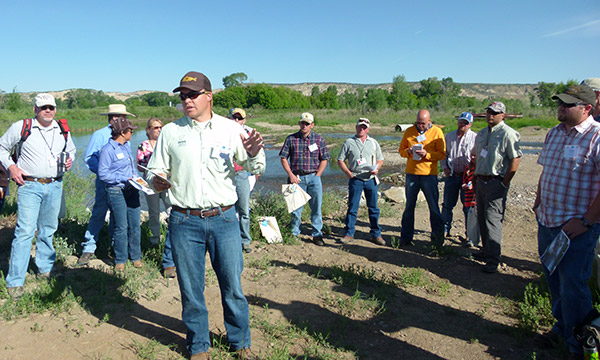Little Snake Watershed
Little Snake River Conservation District
The Place
The Little Snake River is a tributary to the Yampa, Green, and Colorado Rivers in south central Wyoming and north central Colorado. Elevation ranges from 6,000 to 10,000 feet and precipitation ranges from 7 to 55 inches. It is part of the Sierra Madre mountain range and features the northernmost extent of several flora and fauna species of the southern Rockies. It is home to diverse wildlife including game species such as elk, mule deer and antelope and also rare fish and wildlife species such as Colorado cutthroat trout and Greater sage-grouse. Primary land uses remain agriculture (sheep, cattle, and hay), recreation, and energy production.
The Issue
The Little Snake River Conservation District has worked with landowners in the valley for decades on restoration and conservation projects. However, newfound urgency has come to the effort in recent years as a result of increased interest in energy development, residential development coming up from Steamboat Springs, Colorado, and concern about the future of water resources given the extreme water scarcity further down the Colorado River system. These issues have brought challenges, but have also brought opportunity in the form of new funding sources and new conservation partners becoming interested in the work of the district and its assistance to landowners, both private and public.
The Story
The conservation district and landowners in the Little Snake watershed have been building their cooperative conservation effort for some time and have become very adept at harnessing diverse partners and funding sources to achieve their conservation vision. Work has included wetland restoration such as the Muddy Creek Wetland complex, which was constructed as a result of a need for wetland mitigation further east in Wyoming and has become a true desert oasis for waterfowl, shorebirds and other wetland dependent birds. The district and its many partners have completed substantial fisheries restoration both in the mainstem of the Little Snake River and many of its tributaries. Upland work has included extensive wildland fire fuels reduction and aspen restoration projects in cooperation with federal land managers in the upper reaches of the watershed. More recently, the work has moved towards interest in conservation easements to conserve large working ranches while preserving both continued private ownership and sustainable agriculture.
The Partners
In addition to the many private landowners who have partnered with the conservation district, it has worked extensively with both private and public conservation interests including: U.S. Fish and Wildlife Service-Partners for Fish and Wildlife Program, Bureau of Land Management, U.S. Forest Service, USDA-Natural Resources Conservation Service, Wyoming Game and Fish, Wyoming Water Development Commission, Wyoming Department of Agriculture, Wyoming Landscape Conservation Initiative, Trout Unlimited, The Nature Conservancy, and many others.
The Results
The wetland, upland, and aquatic conservation and restoration results achieved by the collaboration in the Little Snake River Valley are substantial and truly at a landscape scale. Of particular interest is the systematic approach that the conservation district has taken to planning its river-based work, For example, integrating fisheries and irrigation projects with upland fuels and aspen work by using logs produced in upland restoration in the development of water work.

Photo: Little Snake Watershed Restoration
During Private Lands Partners Day 2013 attendees were able to tour a number of the restoration projects that the Little Snake River Conservation District has coordinated over the years. The district continues to develop and deliver projects that provide benefit to both people and wildlife including sensitive species such as Colorado cutthroat trout and greater sage grouse. Photo courtesy of Heather Johnson, U.S. Fish and Wildlife Service


